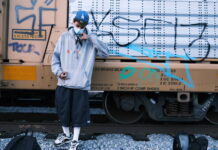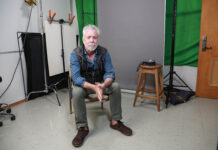ELLIOT GOLAN / BULL
Cognac-colored double doors lead the way. Five paces through a barely two-person-wide passageway and the windowless space is revealed.
Square, black plastic-covered stools surround high square wood tables. A single-play pool table beckons in the distance.
To the right, the bar. Fifteen stools long, a right turn and three more surround it. Behind the bar there are two ancient cash registers, two “cash only” signs, two hanging ukuleles and 10 framed pictures. One stands out.
“That’s Mr. Casey,” says Jean Casey, Lee Casey’s widow and the current owner of Casey’s Tavern.
Below the picture of the snow-bearded man, whose eyes squint as though to intimidate, there is another frame. In it are his rules.
“No swearing or foul language. No baseball hats worn backwards. No bandanas. No tank tops after 6:00 p.m. No damaged or paper I.D. accepted.”
A bar with rules like these seems foreign, as though it was out of an overproduced, well-written sitcom.
Casey’s is a neighborhood bar. Located on Sherman Way in Canoga Park, it enjoys a largely local and regular clientele.
“You might get an 80-year-old man sitting next to a young guy with a mohawk and tattoos,” says Kevin Casey, Jean’s son.
Lee and Jean opened the bar in 1981. After two years, they moved less than a block down the street to their current, larger location to bring Lee’s “lifelong dream” to fruition.
Lee Casey died nearly five years ago, but those who remember him live by his standards.
John Pughe has been tending bar at Casey’s for 13 years. “Unlike other bar owners, Mr. Casey treated his employees with genuine respect,” he says. He called Lee the finest man he has ever worked for.
By all accounts, Lee was a proudman. He served in the 2nd Division of the U.S. Army during The Korean War, earning a Purple Heart and a Bronze Star. His basic philosophy was “To thine own self be true,” according to Pughe. As he makes drinks quietly and methodically, face glistening from sweat in the failing light, he adds, “Mr. Casey would not compromise his own principles for profit.”
Pughe couldn’t be happier in his current position. “I hope to be here as long as I’m alive,” says Pughe.
Jean has been arriving at Casey’s at nine every morning to help with the cleaning and deal with the finances since the day they opened. When she arrives, Kevin is already there, wearing the uniform of his day job at Bicycle John’s Bicycle Shop in Burbank, doing the heavy cleaning to prepare for the business day ahead.
Kevin does this six days a week.
With a youthful exuberance defying her 82 years, Jean leans over the bar, baby blue eyes drifting over the quiet room.
“This is not an Irish bar. This is a back east family bar,” said Jean.
Jean can also be found there on any of the three nights that Casey’s offers live music.
Every Thursday, Saturday and Sunday, the bar’s capacity is put to the test with these lively events. Three different nights of music, three different bands. On Sunday evening from six to nine, the longest standing band performs. The Jelly Roll Jazz band has been playing at Casey’s since the year they opened, although the lineup has changed over the years.
Mike Julian has been with Jelly Roll Jazz for four years. Dressed formally in black slacks and a white dress shirt, he runs his fingers through his messy white hair. “I got the job until I drop dead I guess,” he says chuckling.
Julian loves Casey’s because it’s a “third place.”
“Not work and not home, but that third place you go to,” he says. As more people arrive, hands wave from both the crowd and the band in recognition.
During the playing of the lighthearted and fun “Yellow Dog Blues,” the audience waves their white paper napkins and yells, “hey,” at several points throughout the song.
“We started it years and years ago. Been doing it ever since,” said Jean.
She is unaware of any significance the napkins have to the song.
Loyalty is Lee Casey’s legacy. That loyalty was reciprocated in 1983 when Casey’s moved locations.
“Every bit of the labor was done by the customers,” Jean said, her face filling with pride in her community.
Casey’s has returned the favor.
Next to the pool table and worn wooden “lending library,” with titles ranging from Tom Clancy spy novels to steamy romance pieces by niche icon Danielle Steel, there is a plaque denoting the amounts and methods of the various charitable contributions Casey’s has made.
“For the kids since 1996” is written in neon green on the plaque.
With no hesitation Jean announces the figure with great zeal. “We’ve donated over $117,000 to charity,” Jean said, with most of the money going to handicapped schools.
Next to the bar there is also a certificate that was presented to Casey’s in 1994 by the City of Los Angeles Commission for children, youth, and their families.
It dubs Casey’s “Angels over L.A.” Where you have bars, you usually have bar fights. Countless stories pass between friends about some brawl they witnessed at the local watering hole.
“You’ll never see a fight in here,” bartender Larry Adams said in his stoic, sage-like drone.
Adams has been serving drinks at Casey’s for nine years. Customers notice the difference. Justin Flood, a stagehand, is at Casey’s twice a week. He cites the “atmosphere and good-priced drinks,” as the reasons for his regular visits.
Hank Wardak, who works at a nearby Italian deli, loves Casey’s because “everyone knows your name.” He added that the quiet ambiance and rules make it different from any other bar. While Wardak speaks, a patron drifts by, glass teetering, stating that the “straight-upness” of Casey’s is what makes it different from other bars.
Other bars have taken notice of Casey’s. The Scotland Yard, located fewer than 100 feet from Casey’s, is a busy bar, where a seat is often hard to find and words are tough to hear. One of their bartenders, Martin Brebin, is a regular at Casey’s.
“I’ve been working at the Yard for 12 years and I’ve been drinking at Casey’s for 24,” Brebin said.
With a barely understandable Scottish accent direct from Glasgow, Brebin has nothing but good things to say about Casey’s.
“If you don’t respect the place, you don’t get to be in there. Simple as that,” said Brebin, as he adjusts his Guiness T-shirt.
Kirk Mcpherson, an apprentice bartender at Casey’s, seemed to say it best.
Incapable of mustering words to describe the difference between Casey’s and other bars in the area, he touched his black golf cap with his left hand, took a sip of his drink with his right and chuckled through a big, bright smile.
“Everything,” he said.

Casey’s tavern in Canoga Park attracts such an electric mix of patrons that make you feel right at home as soon you enter. (Melissa Keyes / Bull)


